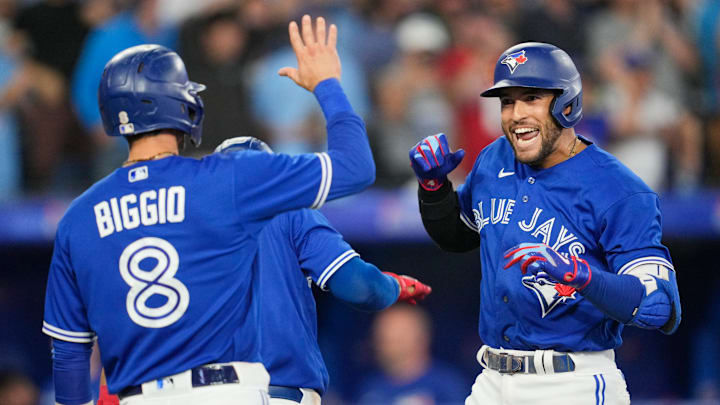Which Blue Jays will be affected by the new shift rules?
Let's start with the Jays who faced the highest shift frequency in 2022, according to Statcast:
Player | Bat Side | Shift Frequency |
|---|---|---|
Brandon Belt | L | 85.2% |
Cavan Biggio | L | 82.8% |
George Springer | R | 59.5% |
Daulton Varsho | L | 48.2% |
You'll notice that three of these players hit from the left side. It's important to note that last season, 55% of left-handed plate appearances across the league came against a shift, compared to 19.6% of right-handed at-bats.
But how much were Jays' batters actually impacted by the shift in 2022, and how much could they stand to gain? Starting on the left side of the plate, here are the four current Jays who hit the most ground balls into a shift last season:
Player | Pulled GB vs. Shift | Hits | AVG |
|---|---|---|---|
Daulton Varsho | 78 | 15 | .192 |
Cavan Biggio | 41 | 6 | .146 |
Brandon Belt | 25 | 2 | .080 |
Kevin Kiermaier | 25 | 1 | .040 |
According to FanGraphs, last year the league average on all pulled ground balls was .178, which dropped to .158 against a shift. With no shift, the average jumped up to .210.
All four of these players should benefit to some degree. Varsho and Kiermaier are the candidates likely to benefit the most, as they're projected to have everyday roles.
Let's start with Kevin Kiermaier.
With a career 50% ground ball rate, Kiermaier hit 25 ground balls into the shift last season, despite only facing a shift 28.1% of the time. If he stays healthy, he could see up to 450 plate appearances, like his 2019 season, in which he hit 183 ground balls, 98 to the pull side.
If the speedy center fielder hits near the league average of .210, he'll wind up with 20 hits from those 98 ground balls. That's a significant gain from the four hits he'd have if the shift still existed, and he had the same .040 average.
Daulton Varsho tops the list because he played a full season in 2022. He pulled 54.5% of his batted balls, with almost half on the ground, for a total of 98.
At .192, he already hit well above the .158 league average against a shift. If he pulls another 98 ground balls this year, with no shift to contend with, he will add five or six hits (if he hits at the .210 league average). If he outpaces the league average again by the same 34 points, that equals nine more hits and will raise his overall average from .235 to .252.
While they faced the highest frequency of shifts last season, playing time is the primary concern for Brandon Belt and Cavan Biggio. They'll have to compile enough at-bats for the new rules to impact their seasons significantly. Belt also likes to hit fly balls (50% the past two seasons), so any effect will likely be minimal.
Biggio will have to force his way into the lineup consistently. If he plays the same amount as last season, even with a 46% pull rate and 35.5% ground ball rate, he only projects for three more base hits if he matches the .210 league mark, which would bring his .202 season average up to .214.
Next, are there any right-handed batters who could reap the rewards from not facing shifts in 2023?
